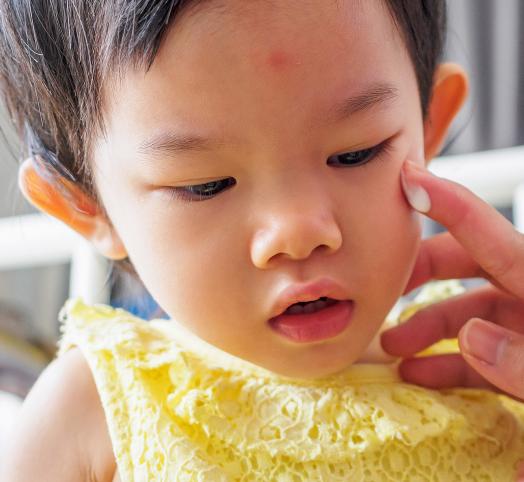How to care for atopic-prone skin?
Updated on March 22, 2023
Created on May 9, 2019
Updated on March 22, 2023
Created on May 9, 2019

Atopic eczema alternates between periods of calm and periods of flare-ups, so how can you relieve child during these periods? Don’t worry, it’s not that complicated.
Written in partnership with Dr. Clarence De Belilovsky, Dermatologist, Member of the Mustela Circle of Experts
If calm periods mean a “break” from atopic eczema in children, they don’t mean a “break” in care. Quite the opposite! This is the perfect time to pamper your baby’s skin, to help it reconstruct and protect itself, and to make it more comfortable (see How to Prevent Atopic Eczema). For this, all you have to do is apply special emollient skin care for babies/children every day – not only does this help rehydrate fragile skin, it is also a real moment of connection with your child (read our dossier on the benefits of emollients). You can even make it a little game— a kiss on the shoulder when the right arm is done, two kisses on the palm the hand when it’s the left arm... not to mention surprise tickle attacks!
Is your baby’s skin starting to show redness? Is it becoming thicker? Does baby have trouble sleeping? A flare-up of atopic eczema is sure to be on the way. You can foresee it and, in this case, don’t hesitate to apply emollient skin care more often than usual, several times a day. This helps to care for extreme dryness. It can even immediately reduce itchiness by up to 95% with Emollient Cream or Stelatopia Emollient Balm. A great asset to have on your side.
Despite all the attention you pay to your baby to avoid having their atopic eczema flair up, it turns up anyway. Try a little two-step action plan if a flare-up occurs:
1. Focus on the red areas. In other words, focus on inflamed areas as soon as they appear. Like many problems, the sooner you treat it, the faster the remedy works and the more effective it is. For this, there’s nothing better than the treatment prescribed by your physician. No matter if it’s just a little irritation or if it’s already “weeping”, these symptoms require special, highly targeted care. You will certainly be prescribed a “topical steroid”, a corticoid-based treatment in ointment or cream form, to be applied directly to the skin.
Its role? To reduce inflammation. Redness, lesions, pruritus, swelling, plaques – let your magic fingers do the trick and it will soothe and, most importantly, it will all go away after a couple of days.
Here, to each type of atopic eczema its own treatment. The one your physician prescribes will not necessarily be the same as for your little neighbor who is also subject to atopic eczema. So don’t worry if the dosage or the duration of use are different. There’s just one line of conduct to follow—only apply the treatment to red patches and during flare-ups for as long as your physician recommends.
2. Keep pampering the skin on the rest of your child’s body. In other words, keep applying emollient care everywhere else, not just on weeping patches. From the face to the feet, right after the bath and/or as many times as necessary in a massage, it will continue to repair the skin, increasing suppleness and moisturization. (read our advice on applying treatment)
Another delight—this emollient care will also help you in fighting itchiness.
A couple of tips can also help you to say goodbye to these unpleasant sensations, or at least not to let them get the best of you:
- Work in a trio. Cold is your ally, as it anesthetizes itchiness—don’t hesitate to use a water mister and/or your emollient care in the refrigerator and take it out just before use, or apply cold compresses, etc.
- If your baby can’t stop scratching, don’t hesitate to cut their nails regularly to avoid cuts from the scratching. This little precaution will no doubt help avoid making things worse!
- If their sleep is disturbed by this, choose high-tolerance bedclothes, 100% cotton textiles such as the new, Stelatopia skin soothing pajamas (create a link). They release soothing natural active ingredients and have effective anti-itch action1, helping children with atopic-prone skin to sleep better within 7 days.2
1 Clinical study, examiners’ assessments of 66 baby/child subjects with eczema-prone skin over 28 days.
2 Consumer study in partnership with the Association Française de l’Eczéma, results at 7 days for 22 babies/children.